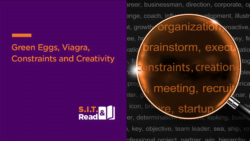Green Eggs, Viagra, Constraints and Creativity
There is little argument that Dr. Seuss is one of the world’s most popular and loved writers. His name is associated with imagination, creativity, talent and originality – and on a personal note – he is one of my favorite writers as well.
In 1954, after reading an article about the shortcomings of books used to teach reading to first-graders, Dr. Seuss was challenged by his friend, William Ellsworth Spaulding, to write a book that first graders “can’t put down”. But there was one additional constraint – he was to write that book using no more than 225 words out of a designated list of 348 words that every first grader should know. Dr. Seuss ended up using 236 words, of which 221 are monosyllabic (!!), to write The Cat in The Hat – a book that has been one of the most successful children’s book ever since.
As if that was not enough, Dr. Seuss’s publisher bet him that he would not be able to write another book using as little as 50 different words. As impossible as that may sound, Dr. Seuss not only won the bet – he did so with a bang. In August 1960 he published Green Eggs and Ham – the book that would become his most successful, and the 4th best-selling English-language children’s hardcover book of all time!
So what’s going on here? How did the unreasonable constraint of writing a book using only 50 different words become the catalyst for one of the world’s most successful and admired books? After all, when we try to be creative we usually go through considerable trouble to break the constraints that limit us, and certainly do not choose to embrace new constraints. Can the explanation simply be the extraordinary talent of Dr. Seuss, or is there something else at play that could be relevant to mere mortals like you and me?
Before we try to answer this question, please take a look at these Viagra TV commercials:
http://www.youtube.com/watch?v=cMhv_wCx5ug
http://www.youtube.com/watch?v=7o8_JjiLpw0
In both these commercials, and for fairly obvious reasons, the advertisers had to avoid describing in detail what their product does, or enables… This constraint is not unique to these specific commercials. What makes them unique, though, is the way the advertisers chose to deal with that constraint.
In many similar cases advertisers have tried to bypass this constraint in various ways, such as portraying men in “the morning after”, filled with energy and joy. But in the examples we just saw there was something very different. They do not contain an attempt to avoid the constraint – quite the contrary. If you think about it, what the advertisers did in both cases is to use the constraint – and in a central and conspicuous manner!
And look at the results: two commercials that are based on a unique element, and are therefore interesting, distinct and memorable; dialogues in which the use of “censorship” leads us to imagine the exact same things you just cannot show on primetime television; a central role for the product itself, as an integral part of the commercial; and last, but not least, a Cannes award for the campaign. All in all not too bad for an idea that was paradoxically inspired by the inability to do what initially seems to be so essential (yes, you can read this sentence again…)
It is interesting to compare this campaign with another Viagra campaign that also uses the same constraint in an unusual manner. Take a look:
http://www.youtube.com/watch?v=ExQKZKnk6rA
In this amusing commercial (that is even funnier the second time you see it) we witness a different way to address the constraint. Here, too, the advertisers are not running away from the campaign using something like “the morning after” approach. Rather, they are facing it head on by replacing the medium which is the object of the constraint – the language itself. The advertisers decided to go ahead and do exactly what they intended to do originally – constraint or no constraint. This “stubbornness” forced them to explore options and alternatives that would never come up were it not for the constraint.
Let’s summarize what we had so far. We saw a few examples in which we recognize a surprising connection between the presences of significant constraints and the ability to develop original and creative ideas. We can even go further to say that in these examples the creative ideas were not developed despite the relevant constraint, but rather because of it.
Yet with all due respect, the constraints did not do the creative work. That has been done by the individuals that chose to address them not as a force majeure that must be submissively accepted, but rather as raw material for a creative exploration. Not as an “end of story”, but as a starting point for a creative negotiation. And that, my friends, is exactly the insight we can take with us, and the state of mind we can learn to adopt.
Not every constraint, in any situation or creative process, can lead us to the development of an award winning campaign or a successful literary masterpiece; but some might, if we just give them (and ourselves) a chance. The widely accepted notion that constraints harm creativity, in not unreasonable; after all, constraints – by their very nature – limit the options available to us. But if we manage to change the way we view them, we may discover that in many cases they simply stop us from settling for the simple, immediate or generic solutions. And thus, by preventing us from taking the path of least resistance, they force us to explore and consider options we would never reach otherwise.
At any rate, in the complex reality we live in, the submissive approach to constraints is an omnipresent problem. When have you last faced a creative challenge, or a problem that needed a solution, in a constraint-free environment??? Constraints surround us in any task and every challenge, so that the ability to use them as a creative opportunity can come pretty handy in our professional lives (and our private ones, by the way). It does not take a lot of resources or complicated preparations – just a shift in our perspective.
So take a few moments to consider the challenges you are facing today, and ask yourselves what constraints make it difficult for you to face these challenges. Maybe these constraints can serve you in the same way the list of words did Dr. Seuss or the censorship the advertisers of Viagra. In what creative ways can you utilize these constraints? Which ideas can they help you come up with, and why are these better than the ones you came up with so far? It may take more than 20 seconds to find meaningful answers for these questions, but if you give it 20 minutes you might be pretty amazed at what you can come up with…
The original version of this article has been published, in Hebrew, on


 Some of these innovation challenges have to do with the process of ideation itself, while others with implementation, some are more relevant on an individual level, and others more on the organizational level. For this discussion, we can define one set of barriers that stop us from coming up with the right ideas (ideation / individual) and another set of challenges involved in the attempt to implement these ideas (implementation / organizational).
Some of these innovation challenges have to do with the process of ideation itself, while others with implementation, some are more relevant on an individual level, and others more on the organizational level. For this discussion, we can define one set of barriers that stop us from coming up with the right ideas (ideation / individual) and another set of challenges involved in the attempt to implement these ideas (implementation / organizational).
